
Edward Winter
(2013, with updates)
In C.N. 2617 Ulrich Dirr (Munich, Germany) asked for information about a game between Capablanca and Edward Lasker which finished as follows:

Black played 40…Ke5 and resigned after 41 h6.
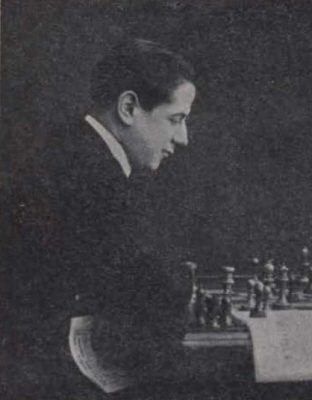
J.R. Capablanca (Wiener Schachzeitung, February-May 1914, page 22)

Ed. Lasker (BCM, May 1914, opposite page 169)
We provide here an expanded version of the reply offered to our correspondent in C.N. 2617. Firstly, the complete score:
1 e4 e5 2 Nf3 Nc6 3 Bb5 a6 4 Ba4 Nf6 5 O-O Be7 6 Re1 b5 7 Bb3 d6 8 c3 O-O 9 d4 Bg4 10 Be3 Nxe4 11 Bd5 Qd7 12 dxe5 Ng5 13 Bxg5 Bxg5
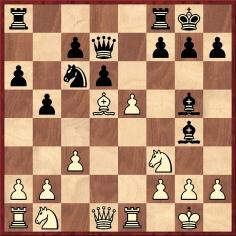
14 Nxg5 Bxd1 15 e6 fxe6 16 Bxe6+ Qxe6 17 Nxe6 Rae8 18 Nd2 Rf6 19 Raxd1 Rfxe6 20 Kf1 Ne5 21 Re3 Kf7 22 Rde1 d5 23 b4 Ng4 24 Rxe6 Rxe6 25 Rxe6 Kxe6 26 h3 Nf6 27 f3 Nd7 28 Ke2 Kd6 29 Nb3 c5 30 bxc5+ Nxc5 31 Nxc5 Kxc5 32 Kd3 b4 33 f4 bxc3 34 Kxc3 d4+ 35 Kd3 Kd5
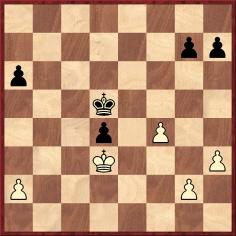
36 g4 g6 37 h4 Kc5 38 g5 Kd5 39 f5 gxf5 40 h5 Ke5 41 h6 Resigns.
The Unknown Capablanca by D. Hooper and D. Brandreth (London, 1975) is a readily available source for the game (pages 148-149). The book recorded that it was played at the Divan Café, London on 17 October 1913 in a simultaneous display in which the Cuban scored +7 –0 =0 in under an hour. The co-authors were critical of both players’ conduct of the ending, where three moves received question marks:
35...Kd5: ‘After 60 years it is time to point out the errors in this endgame. Black should here play 35...h5 reducing the width of the front after 36 g4 hxg4.’ (Page 76 of Capablanca in the United Kingdom (1911-1920) by V. Fiala (Olomouc, 2006) mentioned that 35...h5 was described as preferable in the Standard, 25 October 1913.)
39 f5: ‘Capablanca does not find the correct way to win. He should play 39 a3!! a5 40 a4, and Black is in Zugzwang; e.g. 40...Kc5 41 f5 gxf5 42 h5, or 40...Ke6 41 Kxd4 Kf5 42 Kc5.’
40...Ke5: ‘Black could draw by 40...Ke6 41 Kxd4 f4.’
In contrast, page 39 of Het Schaakphenomeen José Raoul Capablanca y Graupera by M. Euwe and L. Prins (The Hague, 1949) praised the ending (without offering any annotations).

A contemporary source for the game is page 4 of the January 1914 American Chess Bulletin, which observed, ‘Truly a masterful display of endgame tactics, considering the circumstances and the personality of his opponent – the author of Schachstrategie’.

Around the same time, the game appeared with brief anonymous notes on pages 223-224 of Capablanca-Magazine, 31 December 1913:
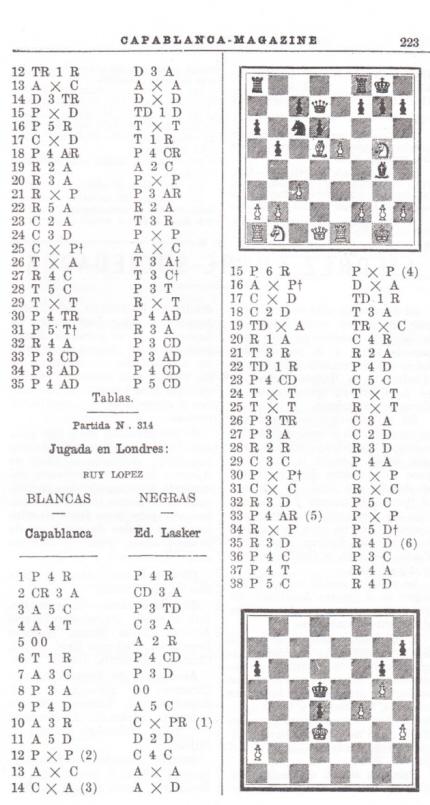
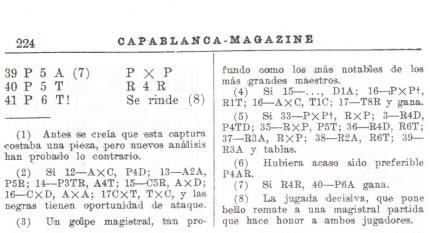
It cannot be assumed that Capablanca himself wrote the notes, although that assumption was indeed made by B. Kagan on pages 13-14 of his book 20 Partien Capablanca’s (Berlin, 1915), which attributed the notes to Capablanca when giving them in a German translation from the Spanish. Regarding the queen sacrifice 14 Nxg5, Kagan added two exclamation marks which were not in the Cuban magazine.


In an article on pages 104-106 of the April 1924 Wiener Schachzeitung, Rudolf Spielmann criticized Capablanca personally for appending ‘!!’ to White’s 14th move and gave analysis to support his view that Black would have won after 14…Bxg5 15 e6 Qd8.


Whereas Spielmann paid no attention to the ending, the full game was examined by J. Mihalik on pages 251-252 of the August 1928 Deutsche Schachzeitung. He censured Black for playing 40…Ke5 instead of 40…Ke6. The latter move he gave two exclamation marks for being the way to draw.


Edward Lasker, for his part, discussed Capablanca’s queen sacrifice on page 192 of the October 1942 Chess Review, where he merely referred to ‘a game I played against Capablanca in London, 1913’, without mentioning that it had occurred in an ultra-brief simultaneous exhibition. He stated that Alekhine had recommended 14 h3 Bxf3 15 Qxf3 Nxe5 16 Rxe5, to which he (Lasker) added analysis beginning 16…dxe5 17 Bxa8 Bc1, and ‘White still has to proceed with great care’.
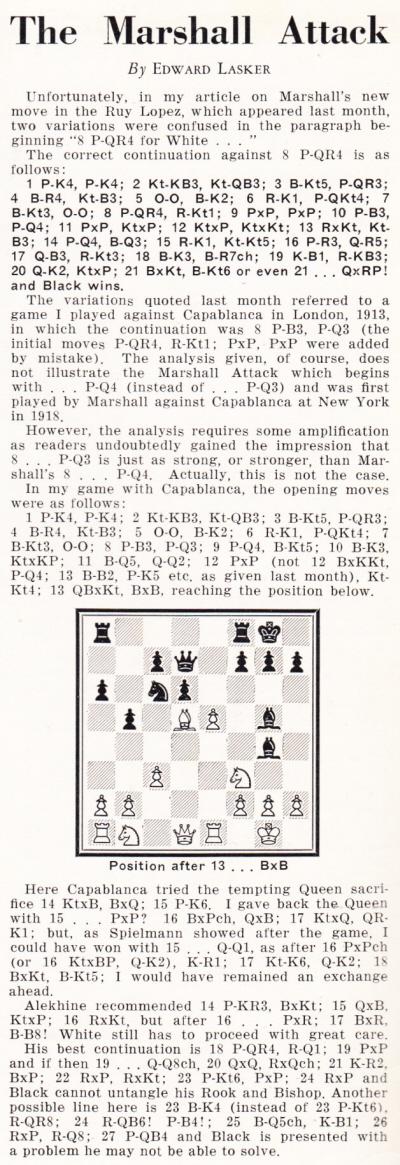
Can more be found by authoritative analysts and annotators?
The above article originally appeared in 2013 at ChessBase.com.
See too pages 34 and 256 of Die hypermoderne Schachpartie by S. Tartakower (Vienna, 1924) and page 126 of Finales de ajedrez, volume one, by Ramón Rey Ardid (Saragossa, 1944).
See, furthermore, Edward Lasker.
To the Chess Notes main page.
To the Archives for other feature articles.
Copyright: Edward Winter. All rights reserved.